France '40 opening moves
Tags
France ‘40 Sickle Cut is an interesting scenario, because historically the Germans launched the campaign with a series of battles in and around Sedan France which left the French defenders demoralized, essentially, routed. Capturing that historical result is difficult. In the game, the French need enough strength to put up more than a token defense, but that much strength could potentially either maul the Germans, or slow them way down, or both.
What this session investigates is how the opening moves play out over the first few turns, focusing on the French 2d Army located south of the Meuse River at Sedan. There are best case first turn attacks for the Germans, but it’s not clear what the risks of those attacks are. This won’t be a complete game, merely a play of the situation in the south. Units in the north will not be moved.
Can we add supply into this? Would like to understand more about manuever warfare.
Here’s the setup:
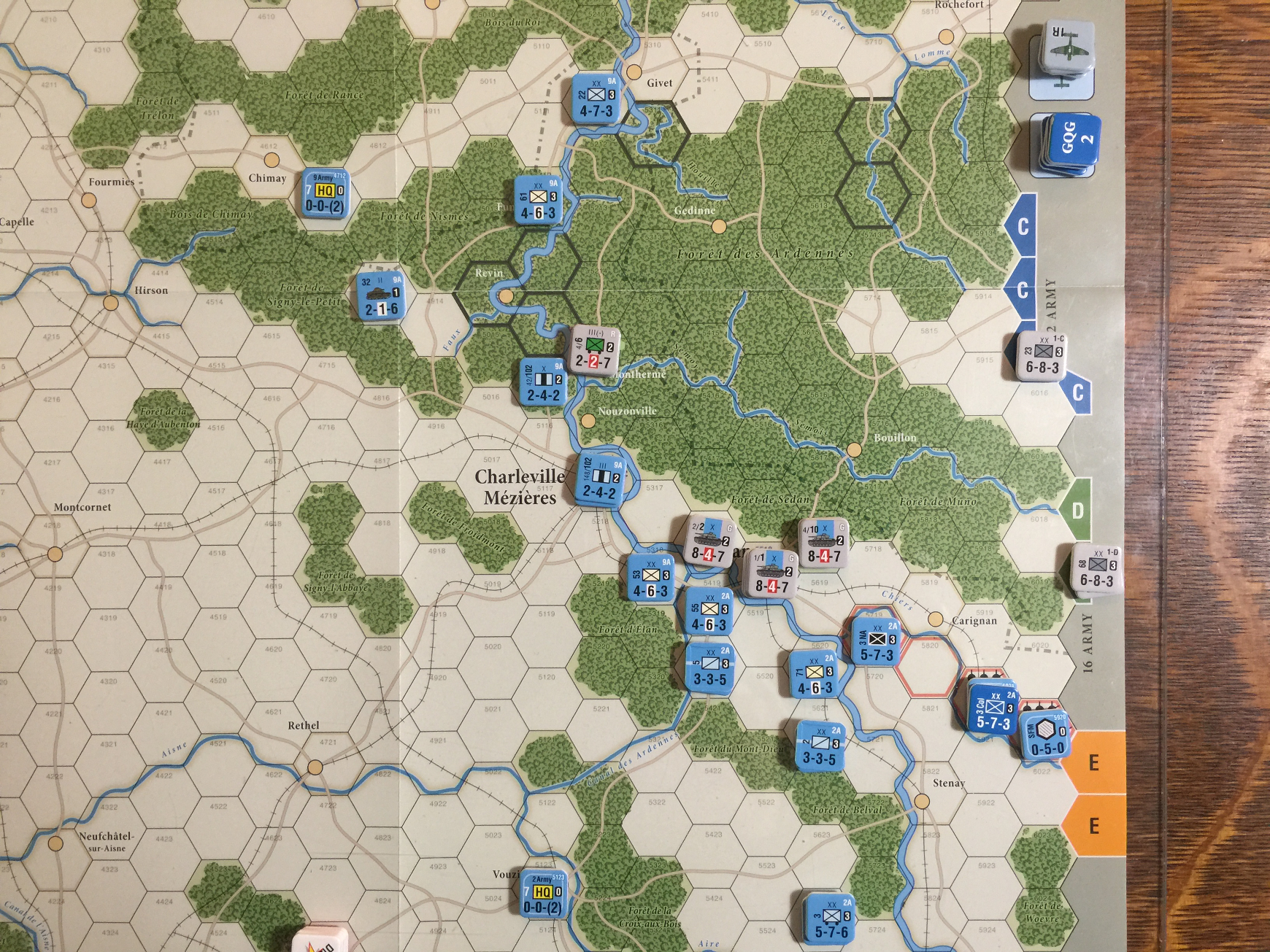
For the first sequence, we won’t roll the dice, we’ll choose the worst result for the combat situation and play it from there.
Worst case results
The worst case result is the Germans don’t ever get across at Sedan. This is what happened during my first Sickle Cut game. This was a result of insufficient aggression and bad rolling. 1 and 10 Pz eventually just left the area and rolled at full strength through the Ardennes and on into western France.
A second worst case result would be losing one or more steps of armor getting across over several turns. I suppose an even worse case would be to lose the armor steps and not get across, and not have that armor for later action in the west.
The “worst” case for a first combat result is successful determined defenses with an attacker step loss.
I think it comes down to whether the Germans should try to cross the Meuse in Turn 1 in the south, or wait until they can bring up infantry to help soak up losses on Turns 2 and 3.
It’s interesting that my attempt at this I roll for both attacks and get a result of attacker loss, and a succesful determined defense.
Turn 1, May 13, 1940
(Turn 1) Provide a broad description of the situation, and some notion of the challenges faced by the Allied and German players. (Remaining turns) Recap the preceding turn, describe challenge for each player in upcoming turn.
German Player Turn 1
Describe the main challenge to the German player this turn, and one or more potential resolutions to the challenge. Explain the situation with respect to overall goal.
German Initial Phase
Flip all Air units from Used to Ready side.
German Movement Phase
- German player may move all, some or none of the German units (7.0).
- Reinforcements enter (19.0).
- Note Extended Movement (7.3) and EZOC +2 MP penalty (5.2).
- Compute Automatic DS (10.1, 14.2)
And here’s an “optimal” attack configuration for the Germans on Turn 1 after the German movement phase:
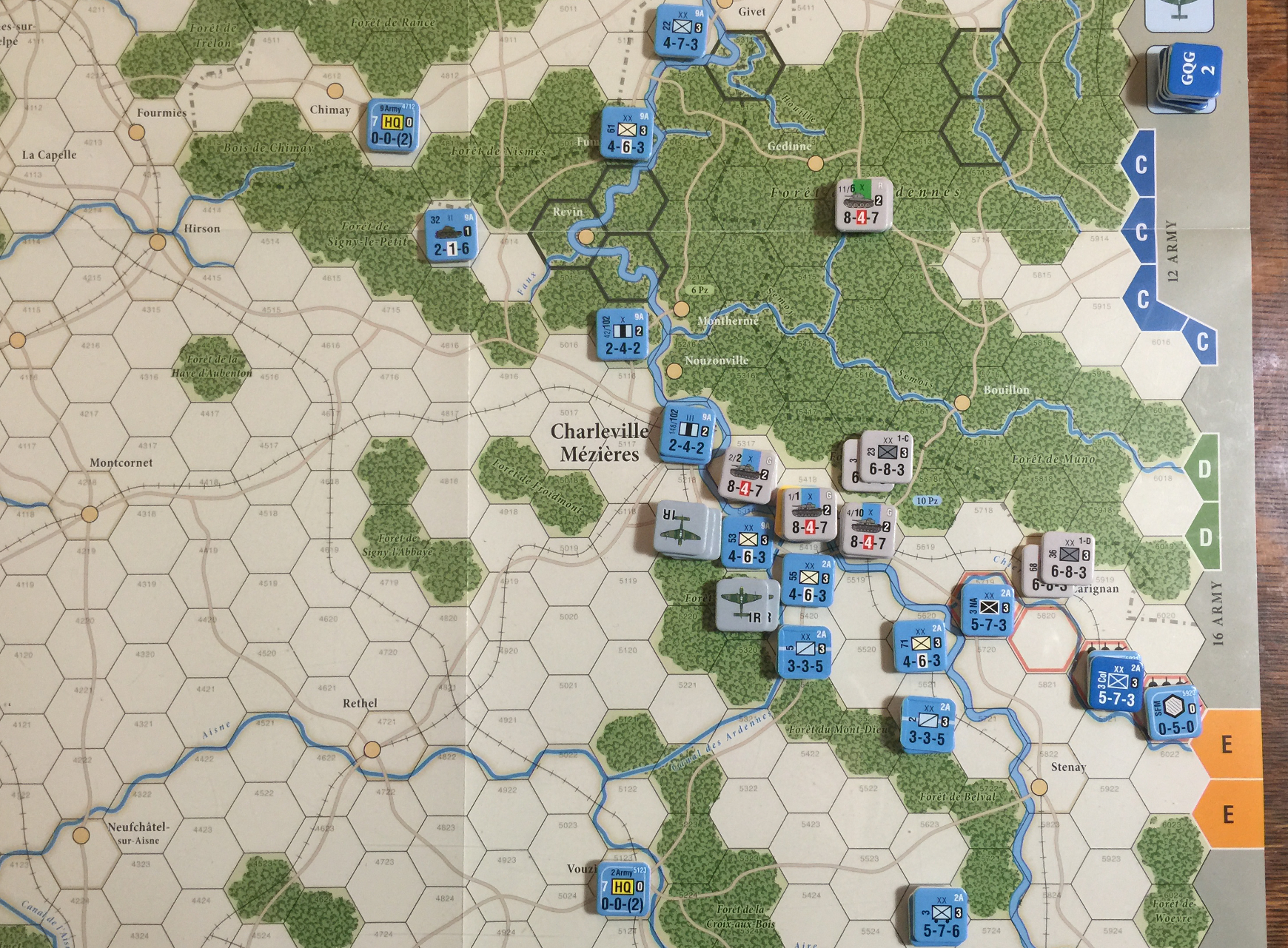
6 Pz is essentially “in reserve” for next turn because it’s vulnerable to a 1:1 (but still dangerous attack) during the Allies phase.
German Combat Phase
German player conducts all attacks (8.0) including Overruns (15.0) and Disengagement Attempts (20.4).
From the picture above, two attacks across the Meuse northwest of Sedan. These are both risky, there is a chance that the Germans will completely fail to cross with any units, and further, take step losses and have to deal with reinforced French units in the same locations next turn. On the other hand, there is a chance that both defending units will completely rout, and allow all German units to advance (modulo stacking and river crossing constraints).
- 1 and 10 Pz attack 55 Inf, GD in reserve. * Defending 6 with low TQ, doubled in defense across river for 12 * Attacking 24 with high TQ, halved attacking across river for 12. * Odds 1:1 with shifts * 2R for Air, 2R for TQ, 1L for HQ, net 4:1.
- 2 Pz attacking 53 Inf. * Defending 6 with low TQ, doubled in defense across river for 12 * Attacking 12 with high TQ, halved in attacking across river. * Odds 1:2 with shifts 2R for TQ, 3R for Air, net 4:1.
This is assuming the French player chooses even odds on HQ left shift. Otherwise the odds could be 5:1 and 3:1, or shifting the Air, 6:1 and 2:1.
36 and 69 Inf. will wait for more reinforcements to attack in the Maginot Line area.
The French have 5 of 6 results which will allow determined defense here. The Determined Defense doesn’t make sense for the French if they have already lost a step, as there is 50% chance they will lose another step and 5/6 chance they would have had to retreat anyway.
Side note: My first game the French got lucky and shut down the Germans completely here, probably because I only made one attack which was an EX result.
What we’ll do here is EX for both attacks, and take the step losses on the panzer brigades. This is really a bad result for the Germans.
German Recovery Phase
Remove Disruption markers if possible (13.3).
Nothing disrupted.
German Supply Phase
- Check supply status (18.0) for all German units
- Roll for attrition (18.5) for
- out of supply units
- units adjacent to enemy units
Everything in supply at the moment.
GQG Phase (Sickle Cut only)
See Section 21.2
All 6 GQG markers go on the board, 2 in the Sedan area on motorized troops, 1 on the 3 DCR in Reims, 1 on the 22 Inf at Givet, and 1 each on DLM 2 and 3 up in the north. The recovery roll removes the GQG on DLM 2 and 3.
Allied Player Turn 1
Describe the main challenge to the Allied player this turn, and one or more potential resolutions to the challenge. Explain the situation with respect to overall goal.
The Germans are stymied at the Meuse. The French can keep them stymied by shoring up the defense.
Allied Initial Phase
- Sickle Cut: Flip all non-Disrupted HQ from Used to Ready (17.2.1).
Allied Movement Phase
- Allied player may move all, some or none of the Allied units (7.0).
- Rail movement ends at least 4 hexes from German, move no more than 15 (7.7).
- (Turn 1 only) Dyle Line construction.
- Reinforcements enter (19.0).
- Note Extended Movement (7.3)
No reinforcements on Turn 1.
All available units move to seal off the Meuse crossing at Sedan. At this point, German attacking here could be ruinous.
Allied Combat Phase
Allied player conducts all attacks (8.0) including Overruns (15.0) and Disengagement Attempts (20.4).
No combat for Allies this turn.
Allied Recovery Phase
Remove Disruption markers if possible (13.3).
Nothing Disrupted.
Allied Supply Phase
- Check supply status (18.0) for all Allied units
- Roll for attrition (18.5) for
- out of supply units
- units adjacent to enemy units
All units in supply.
End Phase
Move the game turn counter and proceed to next turn.
Turn 2, May 14, 1940
(Turn 1) Provide a broad description of the situation, and some notion of the challenges faced by the Allied and German players. (Remaining turns) Recap the preceding turn, describe challenge for each player in upcoming turn.
German Player Turn 2
Describe the main challenge to the German player this turn, and one or more potential resolutions to the challenge. Explain the situation with respect to overall goal.
German Initial Phase
Flip all Air units from Used to Ready side.
German Movement Phase
- German player may move all, some or none of the German units (7.0).
- Reinforcements enter (19.0).
- Note Extended Movement (7.3) and EZOC +2 MP penalty (5.2).
- Compute Automatic DS (10.1, 14.2)
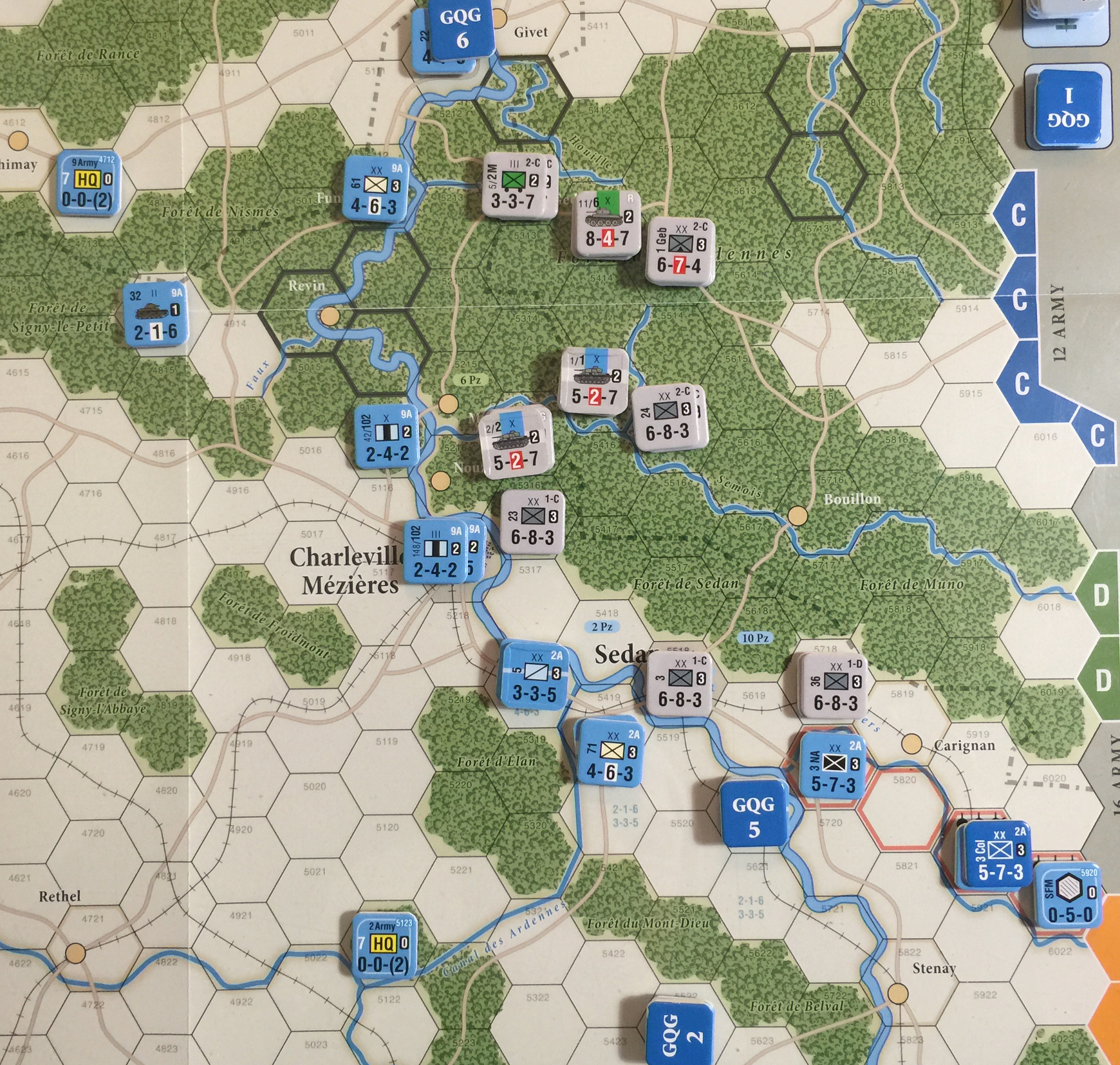
Massing in the Ardennes for a breakthrough at the bluffs. This is leaving the lower part of the German rear exposed to shutting down an entry point by 3 Colonial, but that would lose that unit, D would not be shut down completely, and it would expose the Maginot Line horribly. In a sense, leaving a weak flank is baiting the French to cross the Meuse on an offensive, whence they will get hammered by the Germans.
German Combat Phase
German player conducts all attacks (8.0) including Overruns (15.0) and Disengagement Attempts (20.4).
No combat in the south this phase, assume that the Air units will be used in action up the Dyle.
German Recovery Phase
Remove Disruption markers if possible (13.3).
All good.
German Supply Phase
- Check supply status (18.0) for all German units
- Roll for attrition (18.5) for
- out of supply units
- units adjacent to enemy units
All good.
GQG Phase (Sickle Cut only)
See Section 21.2
GQG 4 & 6 come off, freeing up units to move around the Ardennes.
Allied Player Turn 2
Describe the main challenge to the Allied player this turn, and one or more potential resolutions to the challenge. Explain the situation with respect to overall goal.
The Allies have some hard choices to make here. They are going to have to stretch their lines with weaker units almost surely get retreated which opens up the defensive line.
Allied Initial Phase
- Sickle Cut: Flip all non-Disrupted HQ from Used to Ready (17.2.1).
Allied Movement Phase
- Allied player may move all, some or none of the Allied units (7.0).
- Rail movement ends at least 4 hexes from German, move no more than 15 (7.7).
- (Turn 1 only) Dyle Line construction.
- Reinforcements enter (19.0).
- Note Extended Movement (7.3)
Trains are bringing up reinforcements.
Small movements to close off the Ardennes, making it really hard for the Germans to get through.
Allied Combat Phase
Allied player conducts all attacks (8.0) including Overruns (15.0) and Disengagement Attempts (20.4).
No combat for Allies this turn.
Allied Recovery Phase
Remove Disruption markers if possible (13.3).
All good.
Allied Supply Phase
- Check supply status (18.0) for all Allied units
- Roll for attrition (18.5) for
- out of supply units
- units adjacent to enemy units
All good.
End Phase
Move the game turn counter and proceed to next turn.
Turn 3, May 15, 1940
(Turn 1) Provide a broad description of the situation, and some notion of the challenges faced by the Allied and German players. (Remaining turns) Recap the preceding turn, describe challenge for each player in upcoming turn.
German Player Turn 3
Describe the main challenge to the German player this turn, and one or more potential resolutions to the challenge. Explain the situation with respect to overall goal.
German Initial Phase
Flip all Air units from Used to Ready side.
German Movement Phase
- German player may move all, some or none of the German units (7.0).
- Reinforcements enter (19.0).
- Note Extended Movement (7.3) and EZOC +2 MP penalty (5.2).
- Compute Automatic DS (10.1, 14.2)
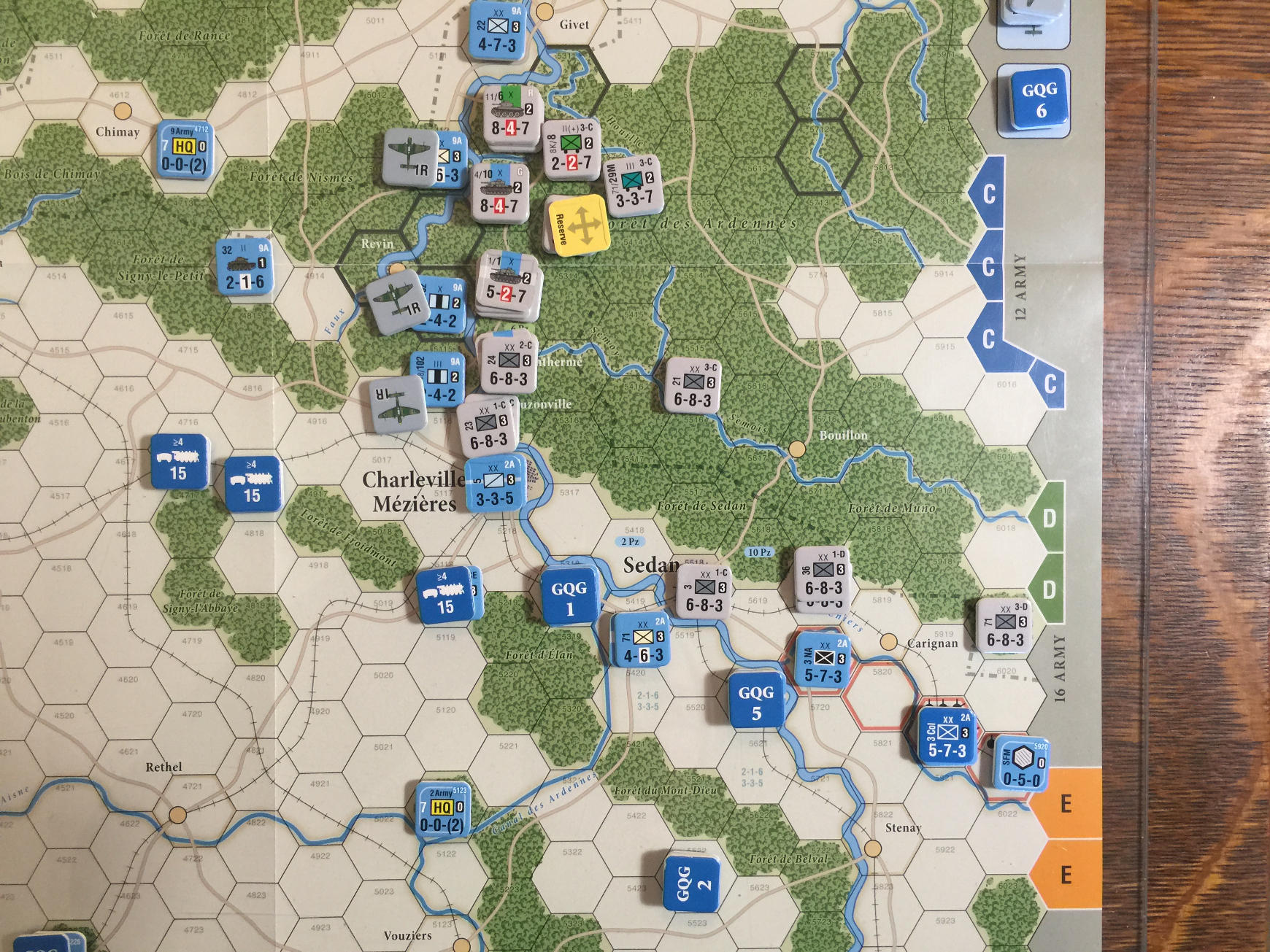
This is exactly what we don’t want to do in this game: get bogged down in frontal assaults.
German Combat Phase
German player conducts all attacks (8.0) including Overruns (15.0) and Disengagement Attempts (20.4).
Three attacks:
- North end: * Defending 61 Inf with 6 double to 12 for river. * Attacking total 24 halved by river to 12. * Odds 1:1 shift 1L for HQ, 2R for TQ, 1R for Air net 3:1. * Roll 4 for DR, French take the retreat to hold the line.
- Middle: * 42/102 Bgd. defense 4 doubled for river to 8. * Attacking 16 halved to 8. * Odds 1:1 shift 1R TQ 1R Air net 3:1 * Roll 4 for DR, French take the retreat as it will hold the line.
- 1:1, crappy but using leg which can take the pounding, roll 2 for A1.
These could have easily been all A1 or EX results intead of DR, in which case the Germans would be in a serious bind. The front is too narrow there to punch through easily, and the French can rotate in fresh units while the Germans grind themselves down in futile attacks.
German Recovery Phase
Remove Disruption markers if possible (13.3).
All good.
German Supply Phase
- Check supply status (18.0) for all German units
- Roll for attrition (18.5) for
- out of supply units
- units adjacent to enemy units
All good.
GQG Phase (Sickle Cut only)
See Section 21.2
Remove 5 & 6, not that big of a deal.
Allied Player Turn 3
Describe the main challenge to the Allied player this turn, and one or more potential resolutions to the challenge. Explain the situation with respect to overall goal.
Still attempting and mostly succeeding in containing the Germans to the Ardennes. I was able to do this more or less successfully my first game, and I’m way ahead of that game already.
Allied Initial Phase
- Sickle Cut: Flip all non-Disrupted HQ from Used to Ready (17.2.1).
Allied Movement Phase
- Allied player may move all, some or none of the Allied units (7.0).
- Rail movement ends at least 4 hexes from German, move no more than 15 (7.7).
- (Turn 1 only) Dyle Line construction.
- Reinforcements enter (19.0).
- Note Extended Movement (7.3)
Train units dismounted and rushed into the breach.
It’s still going to be very difficult to contain the Germans for the next couple of turns. Now that they’re across the Meuse, the French lose that 4 to 1 advantage in defense (double defense on halved attack).
Allied Combat Phase
Allied player conducts all attacks (8.0) including Overruns (15.0) and Disengagement Attempts (20.4).
No combat for the French this turn.
Allied Recovery Phase
Remove Disruption markers if possible (13.3).
Detrained units get recovered.
Allied Supply Phase
- Check supply status (18.0) for all Allied units
- Roll for attrition (18.5) for
- out of supply units
- units adjacent to enemy units
All good.
End Phase
Move the game turn counter and proceed to next turn.
This “game” is interesting as no units have been eliminated for either side, and the Germans have taken as many step losses as the French.
So far, the Allies are “winning.”
Turn 4, May 16, 1940
(Turn 1) Provide a broad description of the situation, and some notion of the challenges faced by the Allied and German players. (Remaining turns) Recap the preceding turn, describe challenge for each player in upcoming turn.
The Germans will continue attempting to punch a hole in the defensive line, the Allies will continue to resist such attempts.
German Player Turn 4
Describe the main challenge to the German player this turn, and one or more potential resolutions to the challenge. Explain the situation with respect to overall goal.
This is a make-or-break turn for the Germans. If they don’t manage to a flank around the Allied line, they run a good chance of never achieving it.
German Initial Phase
Flip all Air units from Used to Ready side.
German Movement Phase
- German player may move all, some or none of the German units (7.0).
- Reinforcements enter (19.0).
- Note Extended Movement (7.3) and EZOC +2 MP penalty (5.2).
- Compute Automatic DS (10.1, 14.2)
If the fighting goes well this turn, there should be some kind of breakthrough.
German Combat Phase
German player conducts all attacks (8.0) including Overruns (15.0) and Disengagement Attempts (20.4).
Three battles:
- North: * Defending 6 * Attacking 12 * 2:1 with 2R TQ, 1R Air 1L HQ net 4:1 roll 6 for D1 star.
- Middle: * Defending 5 * Attacking 15 * Odds 3:1 shift 1R TQ, 1R Air net 4:1 roll 1 for EX.
- South: * Defending 7 * Attacking 15 * Odds 2:1 shift 1R TQ 1R Air 1L HQ net 3:1 roll 5 for A1/D1.
German Recovery Phase
Remove Disruption markers if possible (13.3).
All good.
German Supply Phase
- Check supply status (18.0) for all German units
- Roll for attrition (18.5) for
- out of supply units
- units adjacent to enemy units
All good.
GQG Phase (Sickle Cut only)
See Section 21.2
Remove 4 & 5.
Allied Player Turn 4
Describe the main challenge to the Allied player this turn, and one or more potential resolutions to the challenge. Explain the situation with respect to overall goal.
Allied Initial Phase
- Sickle Cut: Flip all non-Disrupted HQ from Used to Ready (17.2.1).
- Dynamo: Flip all RAF units from Used to Ready (22.6).
Allied Movement Phase
- Allied player may move all, some or none of the Allied units (7.0).
- Rail movement ends at least 4 hexes from German, move no more than 15 (7.7).
- (Turn 1 only) Dyle Line construction.
- Reinforcements enter (19.0).
- Note Extended Movement (7.3)
Looks like the Germans have at least some sort of breakthrough. What the Allies did last time was pinch this off to run the Germans out of supply by the end of the game. That’s going to have to be the strategy this time as well. However, may be able to pinch them off a lot earlier.
Allied Combat Phase
Allied player conducts all attacks (8.0) including Overruns (15.0) and Disengagement Attempts (20.4).
One combat, which was probably ill-advised, taking on the GD at 1:1 raw, which was 1:2 with a shift. Roll was 6, but the unit was surrounded, so totally eliminated while taking down GD one step. Determined Defense failed. It would have been better to leave this unit in there to roablock the Germans with its ZOC.
Allied Recovery Phase
Remove Disruption markers if possible (13.3).
Recover detrained units.
Allied Supply Phase
- Check supply status (18.0) for all Allied units
- Roll for attrition (18.5) for
- out of supply units
- units adjacent to enemy units
All good.
End Phase
Move the game turn counter and proceed to next turn.
All done.
AAR
This is the end of this small game, as shown below:
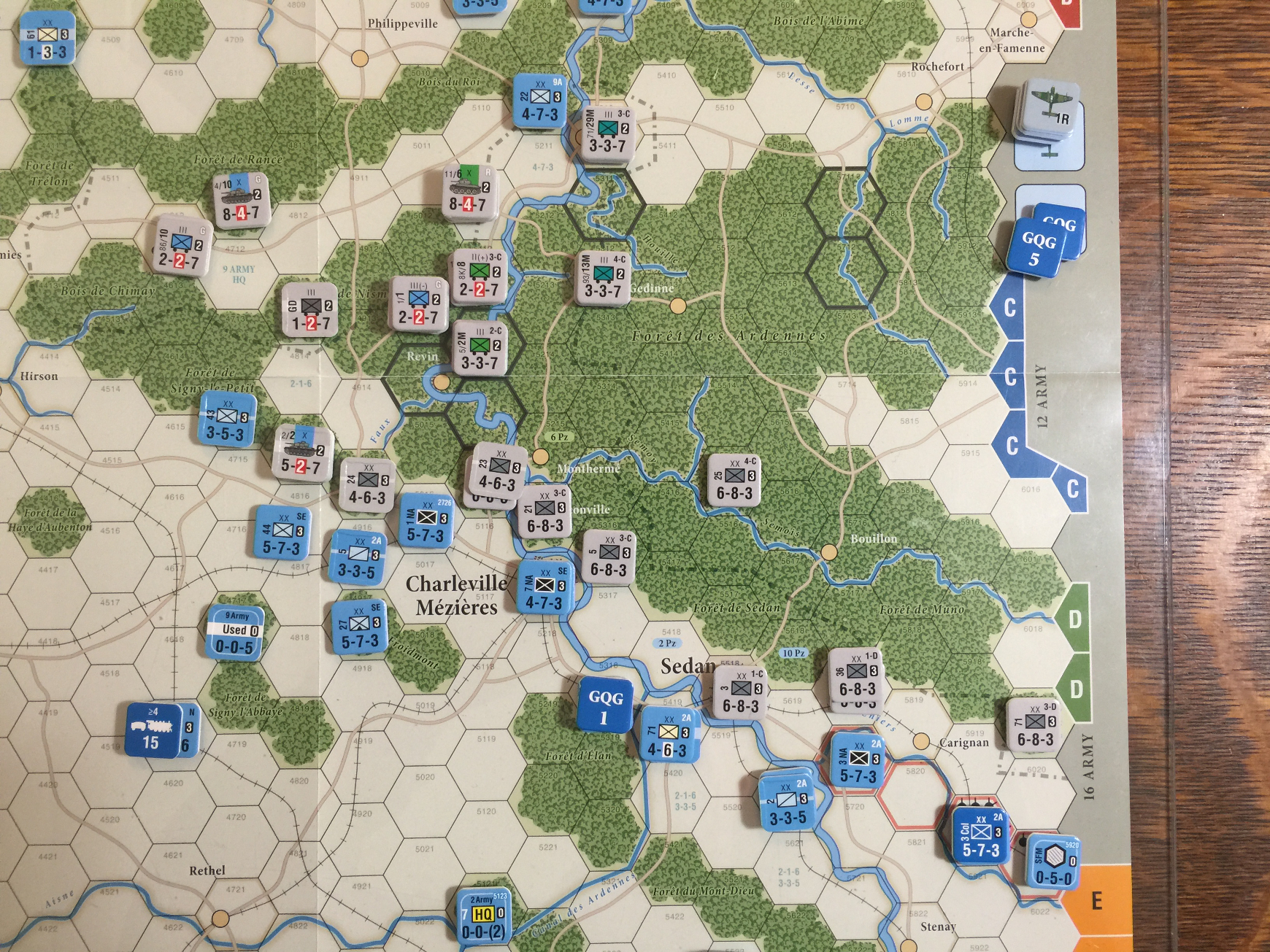
What would happen next for the Germans is a swing to the south to surround the forces around Charleville and run them out of supply. This would force them to either pull way back, or lose units fighting. Not sure if it would work, would be fun to try. The last game I sent the Germans straight west without paying enough attention to the salient.
A small scenario
A good scenario might be to make victory points depend on how many German units can get to hex 4000 by the end of Turn 5. Reinforcements could be abstracted in on the Train by retarding movement for a turn, and allowing only 5 hexes movement first train move.
The situation in the north could probably be handled the same way. For the first few turns, these seem to be completely different battles.